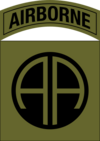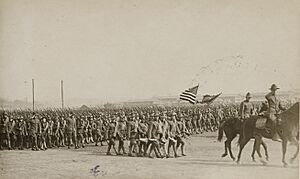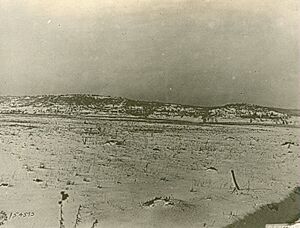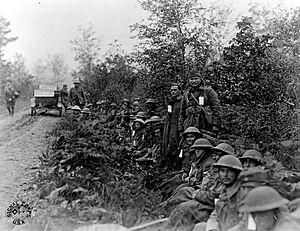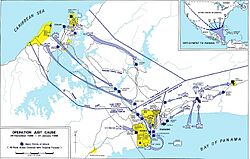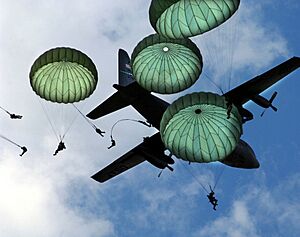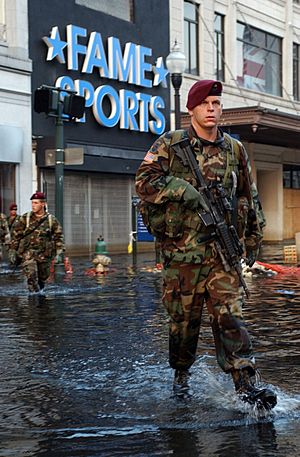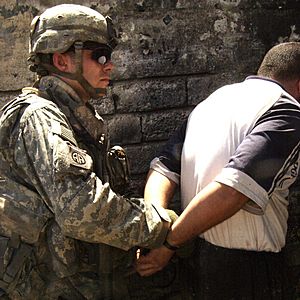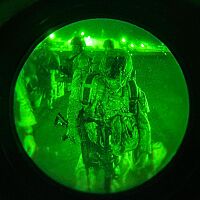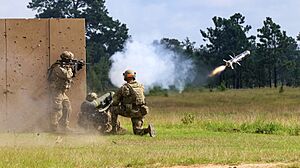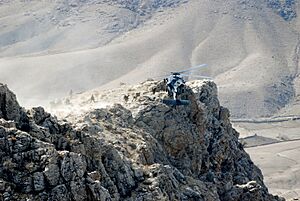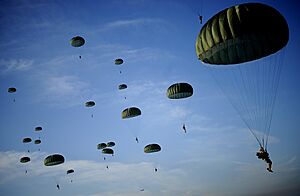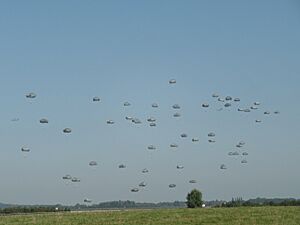82nd Airborne Division facts for kids
Quick facts for kids 82nd Airborne Division |
|
|---|---|
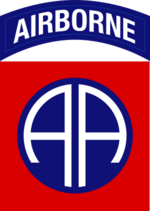
Insignia of the 82nd Airborne Division
|
|
| Active | 1917–1919 1921–present |
| Country | |
| Branch | |
| Type | Airborne light infantry |
| Role | Airborne assault |
| Size | Division |
| Part of | |
| Garrison/HQ | Fort Liberty, North Carolina, U.S. |
| Nickname(s) | "America's Guard of Honor" "All American Division" "82nd Division" "Eighty Deuce" "The 82nd" |
| Motto(s) | "All The Way!" |
| Color of berets | Maroon |
| March | "The All-American Soldier" |
| Engagements |
|
| Website | Official Website of the Division: https://www.army.mil/82ndairborne |
| Commanders | |
| Commander | MG J. Patrick Work |
| Deputy Commander – Operations | BG Andrew Saslav |
| Deputy Commander – Support | COL Jason Williams |
| Deputy Commander – Plans | Brigadier David Pack, British Army |
| Command Sergeant Major | CSM Randolph Delapena |
| Notable commanders |
Complete list of commanders |
| Insignia | |
| Shoulder sleeve insignia (subdued) | |
| Combat service identification badge | |
| Flag | |
| Seal | |
The 82nd Airborne Division is a special United States Army unit. Its soldiers are trained to jump out of planes using parachutes. They can quickly go into dangerous areas to help. The U.S. Department of Defense says they must be ready to fight "any time, anywhere."
This division is based at Fort Liberty, North Carolina. It is known for being the U.S. Army's fastest-moving division.
The 82nd Division started on August 25, 1917, in Georgia. It fought bravely in World War I. Because its first soldiers came from all 48 U.S. states, it got the nickname All-American. This is why their shoulder patch has "AA" on it. In August 1942, during World War II, it became the first airborne division in the U.S. Army. It then fought in many important battles.
How the 82nd Division Started
The 82nd Division began on August 5, 1917, during World War I. It was an infantry division, meaning its soldiers fought on foot. It was officially started on August 25, 1917, at Camp Gordon, Georgia.
At first, the soldiers were from Alabama, Georgia, and Tennessee. But many were soon moved to other units. New soldiers came from states all over the U.S. In April 1918, Major General Eben Swift chose the nickname "All American." This showed that the 82nd had soldiers from every one of the 48 states.
The division had two main groups of soldiers called brigades. Each brigade had two regiments of infantry and a machine gun battalion. There was also an artillery brigade with cannons. In May 1918, the division sailed to Europe. They joined the American Expeditionary Forces (AEF) on the Western Front.
The 82nd in World War I
In early April 1918, the 82nd Division traveled from U.S. ports to England. By mid-May 1918, they were all together. From England, they moved to France. The division then went to the Somme region. Here, small groups of soldiers went to the front lines to learn about combat. On June 16, they moved to the French part of the front.
Fighting at Saint-Mihiel
The 82nd Division trained with British forces starting in May 1918. They then moved to the Lorraine region in France. They stayed there from June to September, getting ready for the Saint-Mihiel offensive.

When the attack on Saint-Mihiel began on September 12, the 82nd Division helped protect the main U.S. Army. They stopped German forces from attacking the side of the First Army. This allowed other U.S. units to move forward. The 163rd Brigade and 327th Infantry Regiment advanced northeast. They raided towns like Port-sur-Seille and Eply. The 328th Infantry Regiment moved west of the Moselle River. They met up with another U.S. division and entered the town of Norroy. This helped make U.S. positions stronger.
By September 17, the Saint-Mihiel battle was calmer. Plans began for the Meuse-Argonne offensive. The 82nd Division was then moved to a reserve area. They had faced heavy artillery fire, which was new to the American soldiers. From September 26 to October 3, the division rested and trained. They got ready for the next big battle.
The Meuse-Argonne Offensive
The division moved to the Clermont area in Argonne on September 24. They were kept as a reserve for the U.S. First Army. On October 3, Major General George B. Duncan took command of the 82nd.
On the night of October 6, 1918, the 164th Brigade took over the front line. They were along the Aire River. On October 7, the 82nd Division attacked the edge of the Argonne Forest. They captured "Hill 223." Part of the division entered the town of Cornay. The other part took high ground northwest of Châtel-Chéhéry. By October 9, the division's left side moved forward.
Throughout October, the division moved northeast along the Aire River. On October 10, they took over from other troops in Ardennes. The 82nd Division then attacked Cornay again. They successfully made the front line stronger there. On October 11, the right side of the division took high ground. The left side kept moving along the Aire. The next day, other divisions took over some of their positions. On October 15, the 82nd broke through the strong Hindenburg Line.
On October 18, the 82nd Division took over from another division. Three days later, they advanced further. On October 31, most of the 82nd was replaced by other divisions. They went to the Argonne Forest to regroup. On November 10, they moved to training areas. They stayed there until the war ended on November 11, 1918.
After the First World War
The division had 995 soldiers killed and 7,082 wounded. This was a total of 8,077 casualties. After the war, the division moved to training areas. They stayed there until February 1919. They returned to the United States in April and May. The division was then officially stopped on May 27, 1919.
Between the World Wars
The 82nd Division was brought back on June 24, 1921. It became part of the Organized Reserve. Its home area included Florida, Georgia, and South Carolina. The division headquarters was in Columbia, South Carolina.
During these years, the division trained often. They practiced at Camp McClellan, Alabama. Soldiers from different parts of the division trained with other Army units. For example, the artillery trained at Fort Bragg, North Carolina. The engineers trained at Fort Benning, Georgia.
The division also helped with training camps for citizens. They took part in large practice exercises with other Army units. However, the 82nd Division did not join the biggest exercises. This was because they did not have enough soldiers or equipment.
The 82nd in World War II
Becoming an Airborne Division
Before World War II, the Army changed how its divisions were set up. The 82nd Division was officially brought back on March 25, 1942. It was at Camp Claiborne, Louisiana. Major General Omar Bradley was its first commander. Many new soldiers joined the division from across the U.S.
On August 15, 1942, the 82nd Infantry Division made history. It became the first airborne division in the U.S. Army. It was renamed the 82nd Airborne Division. The Army chose the 82nd because its soldiers had already finished basic training. Also, its location had good weather and flying facilities.
The division first had three infantry regiments. Two of these were glider infantry regiments. This meant soldiers would land in gliders. One was a parachute infantry regiment. This meant soldiers would jump with parachutes. Later, the division changed to have two parachute infantry regiments and one glider infantry regiment.
Fighting in North Africa and Italy
In April 1943, the 82nd Airborne Division went to North Africa. This was part of the Allied plan to invade Sicily. The division's first two combat missions were parachute jumps. The first was into Sicily on July 9, 1943. The second was into Salerno, Italy, on September 13, 1943. The Sicily jump was the first time a U.S. Army regiment jumped into combat.
During the invasion of Italy, the 82nd fought bravely. One of its regiments, the 504th, earned a special nickname. German officers called them "Devils in Baggy Pants." This name came from a German officer's diary.
D-Day in Normandy
The 82nd Airborne was ready for its second "D-Day" operation. This was Operation Neptune, part of the Allied invasion of Normandy. For this mission, the division was reorganized. Two new parachute regiments joined the division. This gave them a strong three-parachute regiment force.
On June 5 and 6, 1944, these paratroopers boarded planes and gliders. They took part in the largest airborne assault in history at that time. During the June 6th attack, a soldier named Robert P. Mathias was the first U.S. Army officer killed by German fire. On June 7, the glider infantry arrived to help.
In Normandy, the 82nd earned its first Medal of Honor of the war. It went to Private First Class Charles N. DeGlopper. The division fought for a month straight. They had heavy losses, with 5,245 soldiers killed, wounded, or missing. This was 46% of their strength. Major General Ridgway said they completed every mission and never gave up ground.
After Normandy, the 82nd Airborne Division went back to England to rest. They became part of the new XVIII Airborne Corps. James M. Gavin became the division's commander. At 37, he was the youngest general since the Civil War to lead a U.S. Army division.
Operation Market Garden
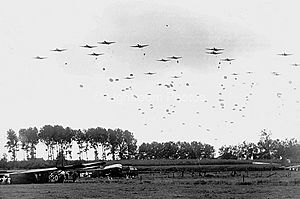
In September 1944, the 82nd prepared for Operation Market Garden. This plan involved three airborne divisions. Their job was to capture key bridges and roads deep behind German lines in the Netherlands.
On September 17, the "All American" Division made its fourth combat jump of World War II. They fought off German attacks. The division captured its goals between Grave and Nijmegen. They faced a tough fight to take the Nijmegen Bridge. On September 20, the 82nd Airborne Division successfully crossed the Waal river under fire. A war reporter called it a battle of great courage.
The 82nd held their positions for several weeks. Then, Canadian troops took over. The 82nd went to France to rest. During this operation, 19-year-old Private John R. Towle was awarded the 82nd Airborne Division's second Medal of Honor.
The Battle of the Bulge

On December 16, 1944, the Germans launched a surprise attack. This was in the Ardennes Forest, known as the Battle of the Bulge. The 82nd was sent to the northern part of the attack.
On December 20, the 82nd Airborne Division was ordered to take Cheneux. They faced strong counterattacks from two German SS divisions. The German efforts to break through failed because of the strong defense by the 82nd and other U.S. units.
On December 23, the Germans attacked from the south. They pushed back the 325th Glider Infantry Regiment. This put the entire 82nd Airborne division in danger. The German goal was to go around the 82nd. But the attack came too late.
By December 24, the 82nd Airborne Division had about 8,520 men. They faced a much larger German force of 43,000 men and over 1,200 vehicles. Because of this, the 82nd Airborne Division had to pull back for the first time. The Germans followed them. The 82nd fought hard until December 28. The German attack in the northern part of the Bulge then ended.
On January 3, 1945, the 82nd Airborne Division attacked back. On the first day, they pushed back the German forces. They captured 2,400 prisoners. The 82nd Airborne had many casualties. One attached unit, the 551st Parachute Infantry Battalion, was almost completely destroyed. Only 110 out of 826 men survived.
After several days of fighting, the German units were defeated. The first part of the Battle of the Bulge ended for the 82nd Airborne Division.
Moving into Germany
After securing the Ruhr area, the 82nd Airborne Division moved into Ludwigslust. They went past the Elbe River. On May 2, 1945, they accepted the surrender of over 150,000 German soldiers. General Omar Bradley said that the British commander thought it was too hard to cross the Elbe. But when the 82nd crossed, they moved 36 miles in one day. They captured over 100,000 enemy troops.
After Germany surrendered, the 82nd Airborne Division went to Berlin. They were there for occupation duty. General George S. Patton was very impressed with the 82nd's "honor guard." He called them the best he had ever seen. This is why the "All-American" division also became known as "America's Guard of Honor."
World War II Casualties
- Total battle casualties: 9,073
- Killed in action: 1,619
- Wounded in action: 6,560
- Missing in action: 279
- Prisoner of war: 615
Awards in World War II
The 82nd Airborne Division and its soldiers earned many awards:
- Distinguished Unit Citations: 15
- Medal of Honor: 4 (including John R. Towle, Charles N. Deglopper, Leonard A. Funk Jr., and Joe Gandara)
- Distinguished Service Cross: 37
- Silver Star: 898
- Bronze Star Medal: 1,894
- French Croix de Guerre with Palm
- Belgian Fourragere 1940
- Military William Order, for bravery in Nijmegen 1944
The Cold War Era
After World War II
The 82nd Airborne Division returned to the United States on January 3, 1946. They took part in the Victory Parade in New York City. Instead of being stopped, the 82nd found a permanent home at Fort Bragg. It became a regular Army division on November 15, 1948.
The 82nd was not sent to the Korean War. Presidents Truman and Eisenhower wanted to keep it ready. It was a strategic reserve in case of a Soviet attack anywhere. In the 1950s and 1960s, the 82nd trained very hard. They trained in places like Panama and the Far East.
Helping During Riots
Detroit in 1967
On July 24, 1967, President Lyndon B. Johnson ordered the U.S. military to Detroit. About 4,700 paratroopers from the 82nd and 101st Airborne Divisions arrived. They helped clean up, find missing people, and patrol the streets.
The rioting was very intense. The 82nd worked with the 101st to secure the eastern part of the city. The National Guard took the western part. Incidents decreased as paratroopers patrolled with their weapons. Police began arresting people who broke curfew or were looting. By July 27, the city was calmer. The riot was officially over. The Army began to leave, giving control back to local police.
Washington, D.C., and Baltimore in 1968
The 82nd was called to help with civil disturbances in Washington, D.C., and Baltimore. These riots happened after the assassination of Martin Luther King Jr. on April 4, 1968. On April 6, the first soldiers from the 82nd arrived in Washington. More than 2,000 82nd paratroopers helped local police and the National Guard.
The rioting had mostly ended, but some looting and fires continued. On April 8, the 1st Brigade moved to Baltimore to help there. The 82nd helped keep order, arrested looters, and cleared debris. They also helped restore essential services like sanitation and food stores. On April 12, federal troops and National Guardsmen were ordered to return home. The 82nd brigades left both cities.
Operations After Vietnam
From 1969 to the 1970s, the 82nd sent soldiers to South Korea and Vietnam. They trained for future battles. The division was put on high alert several times. In 1970, they were almost sent to Amman, Jordan, but the mission was canceled. In 1971, they helped police with protestors in Washington, D.C.
In 1979, the division was ready for a possible mission to rescue American hostages in Iran. The 82nd became the core of the new Rapid Deployment Forces (RDF). This was a mobile force always ready to go.
Invasion of Grenada: Operation Urgent Fury
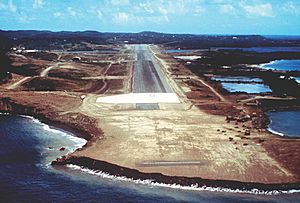
On October 25, 1983, parts of the 82nd landed in Grenada. They helped secure Point Salines Airport. This happened after an airborne assault by Ranger units. The first 82nd unit arrived 17 hours after being told to deploy.
The 82nd expanded its missions from the airport. They worked to find Cuban and Grenadan soldiers. The operation showed how quickly the division could deploy. However, it also showed problems with equipment and communication between different military branches. These issues were later fixed.
Panama: Operation Just Cause
On December 20, 1989, the "All-American" division made its first combat jump since World War II. They jumped onto Torrijos International Airport in Panama. The goal was to remove Manuel Noriega from power. They were joined by other units already in Panama.
The invasion began with a night combat jump and taking over airfields. The 82nd then carried out air assault missions in Panama City and nearby areas. They secured important places like Madden Dam and El Ranacer Prison. The operation involved over 27,000 U.S. troops and many aircraft.
Operation Just Cause showed how quickly the U.S. military could learn from past mistakes. They achieved a fast and decisive victory. The 82nd Airborne Division lost six soldiers out of the 23 total U.S. fatalities. The paratroopers began returning to Fort Bragg on January 12, 1990.
After the Cold War
The Persian Gulf War
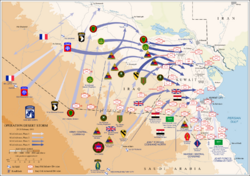
Seven months later, the 82nd Airborne Division was called to war again. Four days after Iraq invaded Kuwait on August 2, 1990, the 82nd was the first ground force to deploy. They went to Saudi Arabia to guard the royal family. This was part of "Operation Desert Shield." The rest of the division soon followed. They prepared for desert fighting against the Iraqi Army.
On January 16, 1991, Operation Desert Storm began with air attacks. The 82nd helped protect the side of the XVIII Airborne Corps. This allowed faster units to move deep into Iraq. The 82nd drove far into Iraq. They captured thousands of Iraqi soldiers and much equipment. After Kuwait was freed, the 82nd returned to Fort Bragg.
Helping After Hurricane Andrew
In August 1992, the 82nd Airborne sent soldiers to South Florida. They provided "humanitarian assistance" after Hurricane Andrew caused great damage. For over 30 days, soldiers gave food, shelter, and medical help to people in Florida. They also provided security for storm victims who had no power or homes.
Operation Uphold Democracy: Haiti
On September 16, 1994, the 82nd Airborne Division was ready for Operation Uphold Democracy. They were set to make combat parachute jumps into Haiti. The goal was to remove Raoul Cédras and bring back Jean-Bertrand Aristide as president.
While the 82nd's first wave of paratroopers was in the air, former U.S. President Jimmy Carter was negotiating with Cédras. When the Haitian military learned the 82nd was on its way, Cédras agreed to step down. This stopped the invasion. Former Vice President Al Gore later thanked the paratroopers. He said the 82nd's reputation alone was enough to change Cédras's mind.
Operations Safe Haven and Safe Passage
On December 12, 1994, the 2nd Battalion (Airborne), 505th Infantry, deployed for Operations Safe Haven and Safe Passage. They went to Panama to "restore order" among Cuban refugees. The refugees had protested their detainment. The battalion helped keep the refugees safe. They patrolled the camps in the Panamanian jungle for two months.
Operation Joint Endeavor: Bosnia
The 82nd prepared for a possible parachute jump into Bosnia-Herzegovina. This was to support other U.S. Army units in Operation Joint Endeavor. However, when engineers successfully bridged the Sava River without fighting, the 82nd's airborne operation was not needed.
Centrazbat '97
In September 1997, the 82nd traveled to Kazakhstan and Uzbekistan for CENTRAZBAT '97. Paratroopers flew 8,000 miles and jumped into an airfield in Shimkent, Kazakhstan. They joined units from other countries for a two-week NATO training mission.
Operation Allied Force: Kosovo
In March 1999, a task force from the 82nd deployed to Albania. They were along the Albania/Kosovo border. This was to support Operation Allied Force, NATO's bombing campaign against Serbian forces. In September 1999, another task force from the 82nd took over. In October 1999, the 1st Battalion, 508th ABCT, made a combat jump in "Operation Rapid Guardian" near Pristina.
The Global War on Terror
Operations in Afghanistan and Iraq
After the 11 September attacks in 2001, the 82nd began deploying soldiers. In October 2001, some soldiers went to Afghanistan for Operation Enduring Freedom. In June 2002, parts of the division headquarters and other units deployed to Afghanistan.
In March 2003, the 2nd Brigade Combat Team was part of a special operations task force. They were to seize Saddam International Airport in Iraq for Operation Iraqi Freedom. The mission changed, and they conducted other operations in Iraqi cities like Samawah, Fallujah, and Baghdad. The brigade returned to the U.S. by February 2004.
In April 2003, an incident occurred in Fallujah. Soldiers from a unit of the 82nd were involved in an event where civilians were killed or wounded during a protest. The battalion had no casualties.
The 3rd Brigade deployed to Iraq in summer 2003. The 1st Brigade deployed in January 2004. By April 2004, all units of the division had left. The 2nd Brigade deployed again in December 2004 to help with elections. During these early deployments, 36 soldiers from the division were killed. About 400 were wounded.
Rapid Deployments
The 82nd continued to be a rapid deployment force. In September 2004, a task force was sent to Afghanistan for emergency deployment. This was to support elections there. In December 2004, other task forces went to Iraq. They provided security for the country's national elections.
Hurricane Katrina Relief
In September 2005, the 82nd Airborne's 3rd Brigade and other units deployed to New Orleans, Louisiana. They helped with search-and-rescue and security after Hurricane Katrina caused severe flooding. About 5,000 paratroopers operated from the airport. They distributed water and food. They also provided security for storm victims.
The Surge in Iraq
In December 2006, the 2nd Brigade Combat Team deployed to Iraq again. This was part of "The Surge" to increase troop strength. They were in northern Baghdad from January 2007 to March 2008. The 1st Brigade deployed to Southern Iraq in June 2007. Since September 11, 2001, the division has lost 20 paratroopers in Afghanistan and 101 in Iraq.
Continued Operations in Afghanistan and Iraq
In December 2008, the 3rd Brigade Combat Team deployed to Baghdad, Iraq. They returned in November 2009. In August 2009, the 1st Brigade Combat Team deployed to Iraq again. They returned in July 2010.
From August to September 2009, the 4th Brigade Combat Team deployed to Afghanistan. They returned in August 2010, having lost 38 soldiers.
In May 2011, the 1st Battalion, 505th Infantry, deployed to Afghanistan. They worked with special operations units. They returned in February 2012, losing two paratroopers.
The 2nd Brigade deployed to the Anbar Province in Iraq in May 2011. This was for Operation New Dawn. Their mission was to train Iraqi Security Forces and help with the U.S. withdrawal. They were among the last U.S. combat units to leave Baghdad. The brigade lost the last American service member in Iraq on November 14, 2011.
Haiti Earthquake Relief in 2010
As part of Operation Unified Response, the 2nd Brigade Combat Team deployed to Haiti. This was on the same day as the devastating 2010 Haiti earthquake. Paratroopers helped by distributing water and food.
Soon after returning from Haiti, elements of the 2nd Brigade deployed to Afghanistan. They served as trainers for the Afghan National Security Forces. In October 2011, the Division Headquarters returned to Afghanistan.
In February 2012, the 4th Brigade Combat Team deployed to Kandahar province. They faced intense combat against the Taliban. The 4th BCT held a five-month siege. They caused many casualties among the Taliban. They pushed the Taliban commander, Mullah Dadullah, out of Kandahar.
As of April 2012, the 1st Brigade Combat Team was in Afghanistan. They operated in Ghazni Province. In June 2012, the 3rd Brigade Combat Team deployed to Afghanistan. They supported heavy combat operations.
In December 2013, parts of the 4th Brigade deployed to Afghanistan again. They were joined by the 1st Brigade in spring 2014. Since September 11, 2001, the division has lost 106 paratroopers in Afghanistan and 139 in Iraq.
Operation Inherent Resolve
On December 19, 2014, it was announced that 1,000 soldiers from the 82nd Airborne's 3rd Brigade Combat Team would go to Iraq. Their mission was to train and assist Iraq's Security Forces.
On November 3, 2016, 1,700 soldiers from the 2nd Brigade Combat Team deployed to Iraq. They took part in Operation Inherent Resolve. They advised and assisted Iraqi Security Forces trying to retake Mosul from ISIS fighters.
On March 27, 2017, 300 paratroopers from the 82nd Airborne's 2nd Brigade Combat Team temporarily deployed to northern Iraq. They provided extra help against ISIS. This was to speed up the offensive in Mosul.
On December 31, 2019, about 750 soldiers from the 82nd Airborne were sent to Iraq. This was in response to events at the U.S. embassy in Baghdad. From January to September 2017, the division lost five paratroopers in action.
Syria Intervention
In July 2020, it was confirmed that the 82nd Airborne Division had combat deployments in Syria.
Operation Freedom's Sentinel
The 1st Brigade Combat Team deployed to Afghanistan from June 2017 to March 2018. This was for Operation Freedom's Sentinel. Two soldiers were killed when their convoy was hit by explosives.
The 3rd Brigade Combat Team deployed to Afghanistan from July 2019 to March 2020. In February 2020, other units replaced them as part of a rotation.
Iranian Threat in Iraq
The 82nd Airborne was called to Iraq after civilians stormed the U.S. embassy in Baghdad. On January 1, 2020, the first 750 troops moved to Kuwait and bases in Baghdad. Iranian general Qasem Soleimani was killed in a U.S. airstrike. This increased tensions in the region. The 82nd Airborne was among the first units sent to respond. An additional 3,500 to 4,000 troops were ordered to Kuwait.
Evacuation of Kabul
In August 2021, parts of the 82nd Airborne Division deployed to Afghanistan. They helped secure the evacuation of American diplomats and Afghan citizens. This happened as the Taliban took over Kabul. The 82nd Airborne Division served as the main command for this mission, called Operation Allies Refuge.
Operation Allies Refuge was a joint effort with NATO nations. It included soldiers from the 1st Brigade Combat Team, aviation units, medical teams, and military police. Major General Chris Donahue led the operation.
How the 82nd Airborne Division is Organized
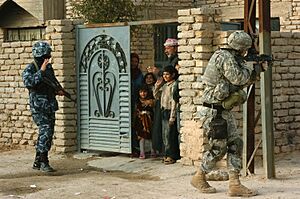
The 82nd Airborne Division has a main headquarters. It also has three infantry brigade combat teams. These are groups of soldiers who fight on foot. It has an artillery unit, a combat aviation unit with helicopters, and a support unit.
 82nd Airborne Division, based at Fort Liberty, North Carolina
82nd Airborne Division, based at Fort Liberty, North Carolina

 Division Headquarters and Headquarters Battalion
Division Headquarters and Headquarters Battalion
 U.S. Army Advanced Airborne School
U.S. Army Advanced Airborne School- 1st Infantry Brigade Combat Team "Devil Brigade"
- 2nd Infantry Brigade Combat Team "Falcon Brigade"
- 3rd Infantry Brigade Combat Team "Panther Brigade"
- 82nd Division Artillery
- 82nd Combat Aviation Brigade "Pegasus Brigade"

 1st Squadron (Attack/Reconnaissance), 17th Cavalry Regiment (AH-64E Apache)
1st Squadron (Attack/Reconnaissance), 17th Cavalry Regiment (AH-64E Apache)
 1st Battalion (Attack), 82nd Aviation Regiment (AH-64E Apache)
1st Battalion (Attack), 82nd Aviation Regiment (AH-64E Apache)
 2nd Battalion (Assault), 82nd Aviation Regiment (UH-60M Black Hawk)
2nd Battalion (Assault), 82nd Aviation Regiment (UH-60M Black Hawk)
 3rd Battalion (General Support), 82nd Aviation Regiment (CH-47 Chinook and UH-60 Black Hawk)
3rd Battalion (General Support), 82nd Aviation Regiment (CH-47 Chinook and UH-60 Black Hawk)
- 82nd Airborne Division Sustainment Brigade
Special Traditions
To remember the 1944 Waal river crossing during Operation Market Garden, the 82nd holds an annual competition. It's called the Crossing of the Waal. The winning company gets a special paddle.
Honors and Awards
Battles and Campaigns
The 82nd Airborne Division has fought in many important battles and campaigns:
- World War I: St. Mihiel, Meuse-Argonne, Lorraine 1918
- World War II: Sicily, Naples-Foggia, Normandy, Rhineland, Ardennes-Alsace, Central Europe
- Armed Forces Expeditions: Dominican Republic, Grenada, Panama
- Southwest Asia: Defense of Saudi Arabia, Liberation and Defense of Kuwait
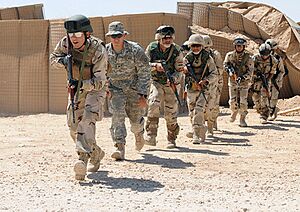
- Operation Enduring Freedom (OEF)
- Operation Iraqi Freedom (OIF)
- Operation New Dawn (OND)
- Operation Inherent Resolve (OIR)
Medal of Honor Recipients
These brave soldiers from the 82nd Airborne Division received the Medal of Honor, the highest military award:
- World War I: Lt. Col. Emory J. Pike, Corp. Alvin C. York
- World War II: Pvt. John R. Towle, Pfc. Charles N. Deglopper, 1st Sgt. Leonard A. Funk Jr., Pvt. Joe Gandara
- Vietnam War: SSG Felix M. Conde-Falcon, Master Sergeant Roy P. Benavidez
Unit Decorations
The entire division or its units have also received special awards:
 Presidential Unit Citation (Army) for Sainte-Mère-Église, Operation Market Garden, Chiunzi Pass/Naples/Foggia, and the Battle of Samawah.
Presidential Unit Citation (Army) for Sainte-Mère-Église, Operation Market Garden, Chiunzi Pass/Naples/Foggia, and the Battle of Samawah. Valorous Unit Citation (Army) for Operation Iraqi Freedom.
Valorous Unit Citation (Army) for Operation Iraqi Freedom. Meritorious Unit Commendation (Army) for Southwest Asia.
Meritorious Unit Commendation (Army) for Southwest Asia. Superior Unit Award (Army) for service at Fort Bragg.
Superior Unit Award (Army) for service at Fort Bragg. French Croix de Guerre with Palm for World War II actions.
French Croix de Guerre with Palm for World War II actions.- Belgian Fourragere 1940.
 Military William Order for bravery in Nijmegen 1944.
Military William Order for bravery in Nijmegen 1944.
Famous Members
Many notable people have served in the 82nd Airborne Division:
- General Lloyd Austin: A high-ranking general who became the U.S. Secretary of Defense.
- General of the Army Omar Bradley: A famous U.S. Army general during World War II.
- Jason Crow: A member of the U.S. House of Representatives.
- John Bel Edwards: The Governor of Louisiana.
- Lieutenant General James M. Gavin: A well-known commander of the 82nd Airborne Division.
- Colonel Chris Gibson: A former New York Congressman.
- Henry Hill: A real-life person from the movie Goodfellas, who served as a cook.
- Wes Moore: The current Governor of Maryland.
- Craig Morgan: A country music singer.
- Patrick Murphy: A former Under Secretary of the Army.
- Lou Rawls: An R&B singer.
- Senator Jack Reed: A U.S. Senator.
- General Hugh Shelton: A former Chairman of the Joint Chiefs of Staff.
- John Steele: A paratrooper famous for getting caught on a church bell tower during D-Day.
- Senator Strom Thurmond: A U.S. Senator who served in World War II.
- William Windom: An actor.
- Sergeant Alvin C. York: A highly decorated soldier from World War I.


